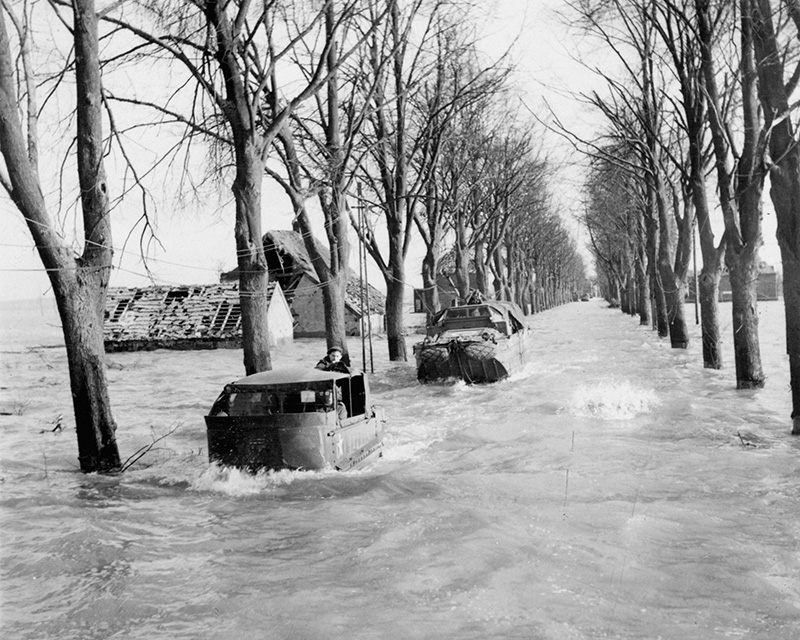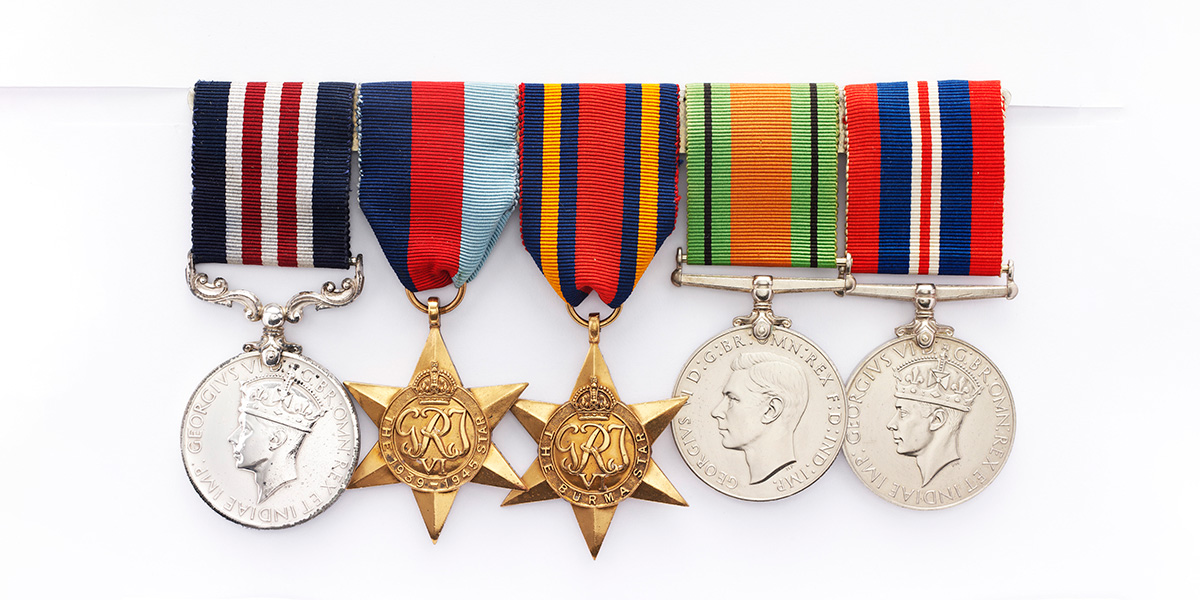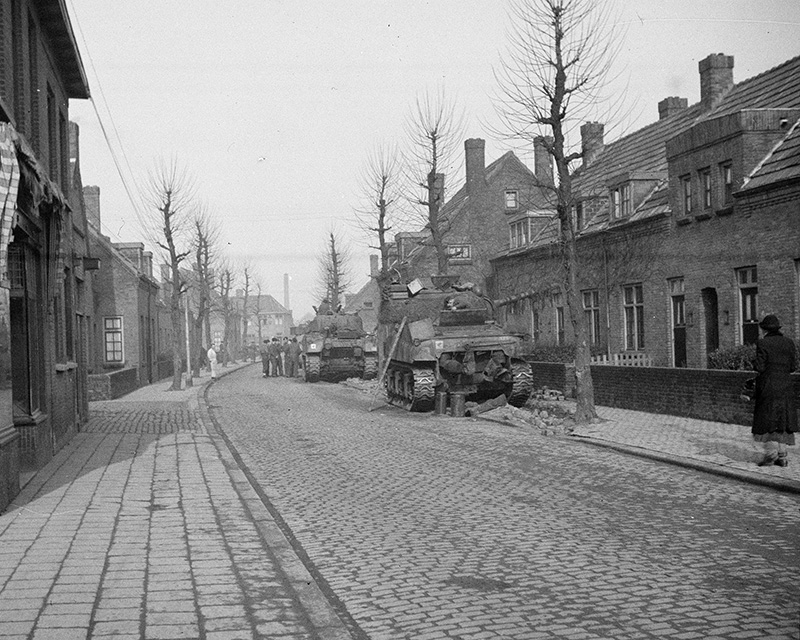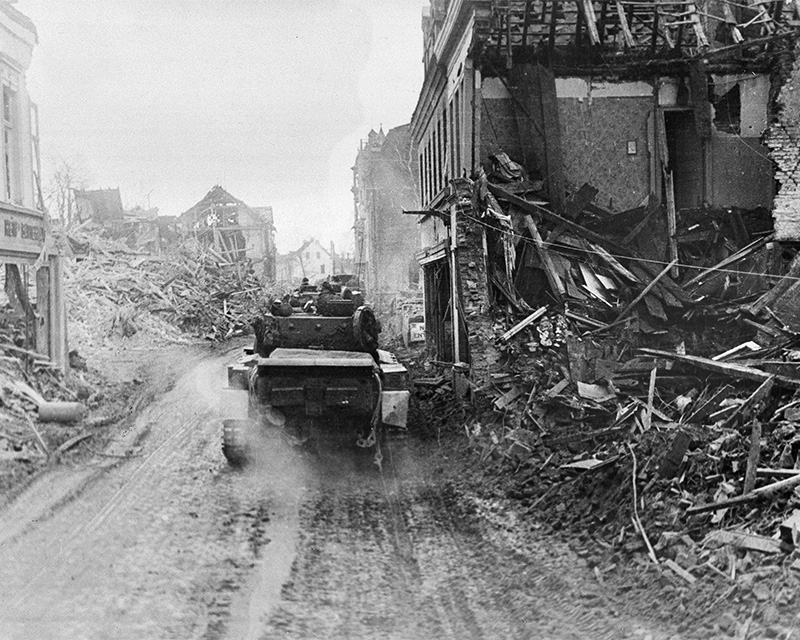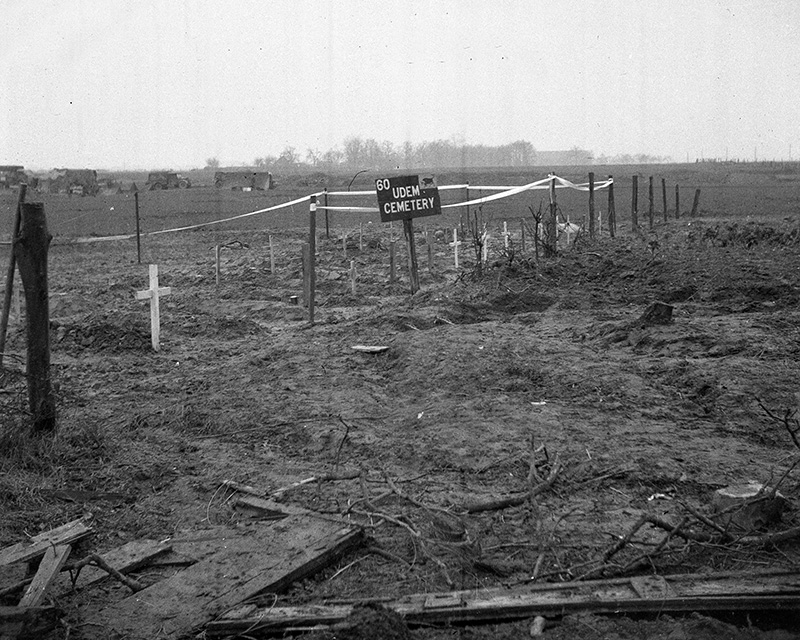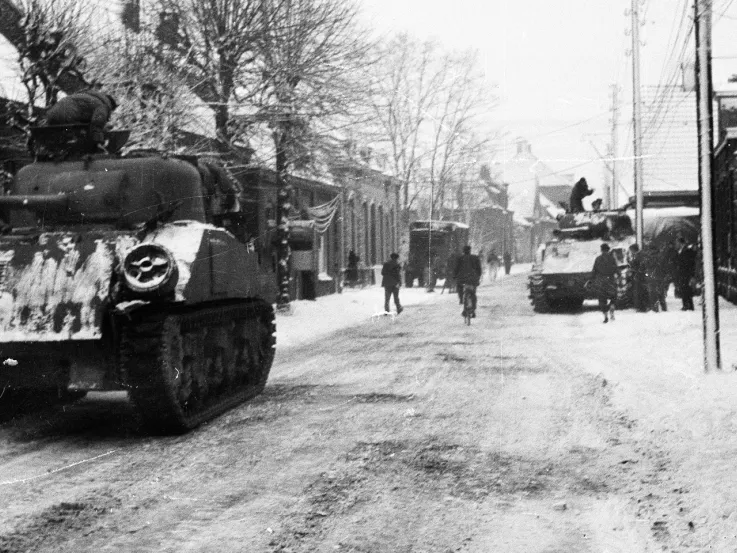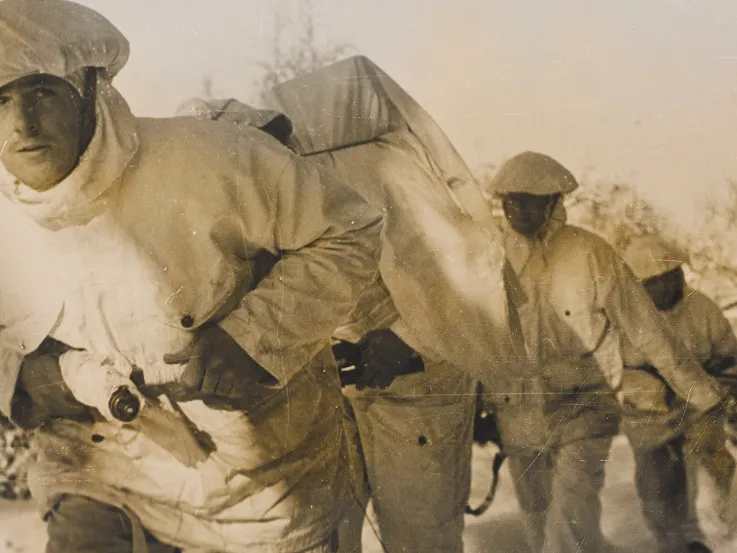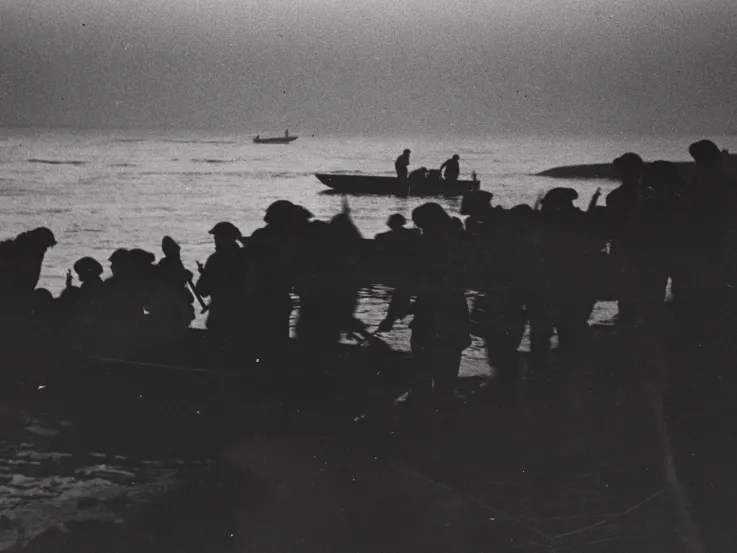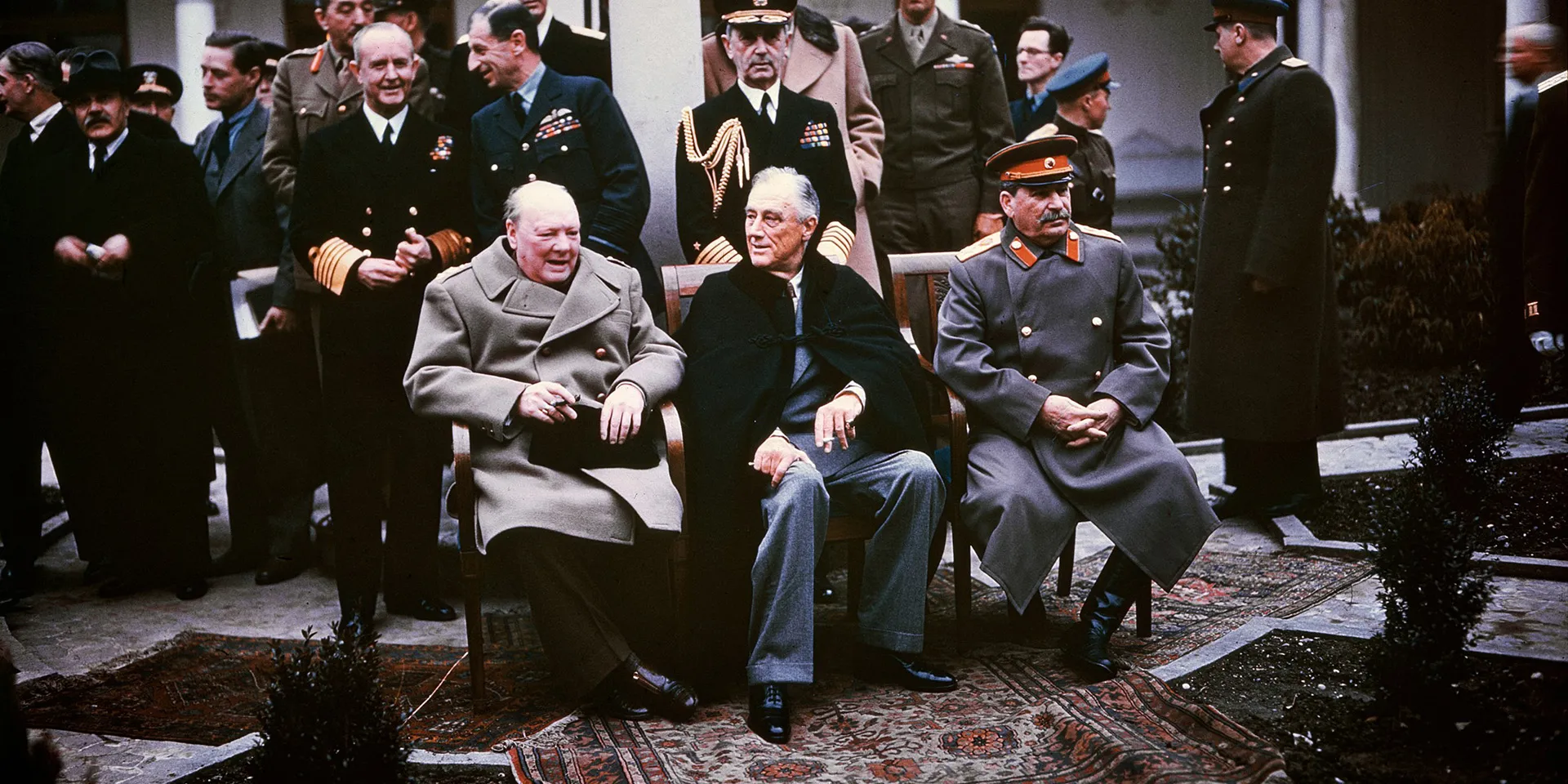
State of affairs
In February 1945, the first major inter-Allied discussions about the postwar world took place. The ‘Big Three’ leaders (Churchill, Roosevelt and Stalin, representing Britain, the United States and the Soviet Union respectively) met at Yalta in Crimea to broach an agreement for the future of Europe.
The conference built upon a series of earlier bipartite summits, most importantly at Moscow in October 1944, when Churchill and Stalin had made the so-called ‘Percentages Agreement’. This secret and informal pact – initially scribbled on a napkin – established a consensus for Soviet influence in Eastern Europe. In an instant, the fortunes of millions were sealed.
At Yalta, more formal plans began to take shape. The ‘Big Three’ agreed Europe’s new borders, declared their intention to restore democracy across all liberated territories, and announced a plan to establish an Allied military government in Germany following their final victory.
With Allied leaders pondering the future peace, the fighting continued unabated across all fronts. In Burma (now Myanmar), British and British Indian forces made huge advances towards the capital. In Europe, British and Allied forces liberated Belgium and much of the Netherlands in the face of stiff resistance. By the end of the month, the fighting had reached German territory, with the Allies pushing towards the last great obstacle in the West: the Rhine River.
These final weeks of the fighting also came at some cost. Across the world, British and Allied soldiers continued to be killed and wounded as the Axis armies maintained a zealous defence in the face of almost certain defeat.

(Image courtesy of the National Archives and Records Administration)
Malta Conference
2 February 1945
At the beginning of the month, British Prime Minister Winston Churchill met with US President Franklin D Roosevelt on the island of Malta. It was an opportunity to plan the final campaign against the Germans in conjunction with the Combined Chiefs of Staff (US and British). The Malta Conference also helped Churchill and Roosevelt prepare for the forthcoming Yalta Conference, where they would be joined by Soviet leader Joseph Stalin.
‘My first day back in Brussels. I visited a Turkish Bath, next door was the British Red Cross, who whilst you were in the bath, collected your uniform and sponged and pressed it. You had your bath, had a haircut, then donned your spruced up uniform and went away feeling like a million dollars.’Lance Sergeant Joe Ashley, Royal Armoured Corps, recalling events in Brussels, Belgium — February 1945
Belgium liberated
4 February 1945
In early February, British and Allied forces liberated the final areas of Belgium still under German occupation. In the final months of the conflict in Europe, Belgium became a vital cog in the Allied war machine as supplies and reinforcements were transported from Britain to the front. Many liberated Belgian towns and cities, including Brussels and Bruges, were also favoured rest centres for British soldiers.
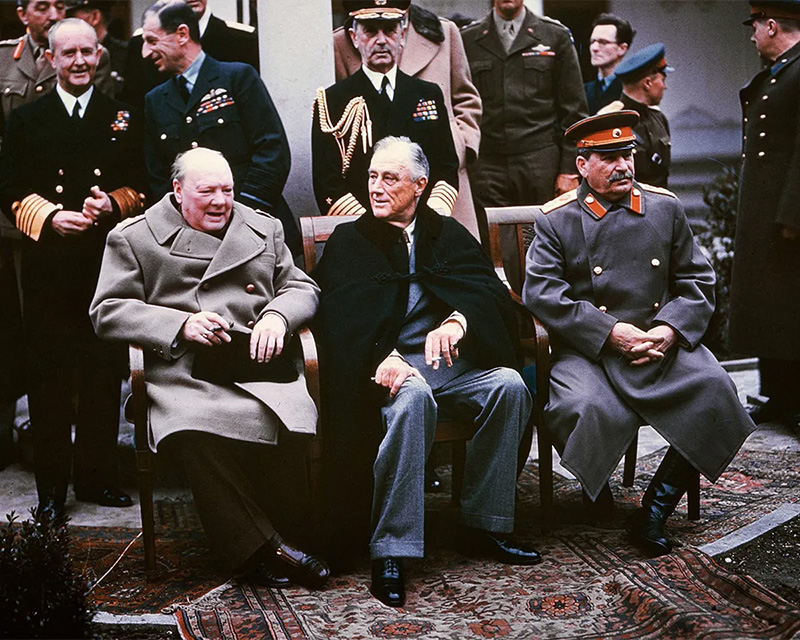
(Image courtesy of The National Archives)
Yalta Conference
4-11 February 1945
The leaders of the ‘Big Three’ powers (Churchill, Roosevelt and Stalin) convened at Yalta in Crimea. This was the first time they had met since November 1943. With the war in Europe approaching its end, there was an urgent need to consider the postwar peace. From questions over collective security and building a durable peace to the precise fate of liberated countries, there was much to discuss.
Several key decisions were made, including the proclamation of restoring democracy across Europe and plans for a military occupation of Germany involving British soldiers. Yet the growing fractures in the wartime alliance were beginning to show and much was left unresolved.
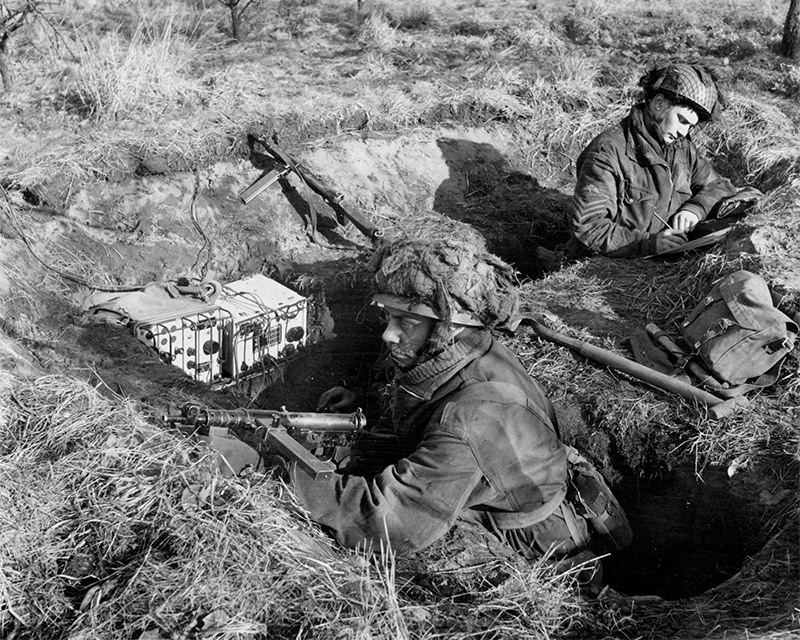
Allied forces sweep through the Netherlands
British and Allied soldiers continued to fight against the remaining German forces in the Netherlands. In areas still under Nazi occupation, Dutch civilians suffered terribly amid food shortages during what became known as the ‘Hungerwinter’. The photograph above depicts soldiers of the 5th Parachute Brigade in the village of Helden on 4 February 1945.
Battle of Pakokku and the Irrawaddy River Operations
4 February – 13 May 1945
On 4 February 1945, British Indian Army forces began a series of battles with the Japanese Army around Pakokku in central Burma. By 14 February, the offensive had reached the western bank of the Irrawaddy with some forces successfully crossing the river at Nyaung-U.
In the weeks that followed, Indian Army troops secured a bridgehead across the Irrawaddy and proceeded to drive on towards the capital, Rangoon (now Yangon).
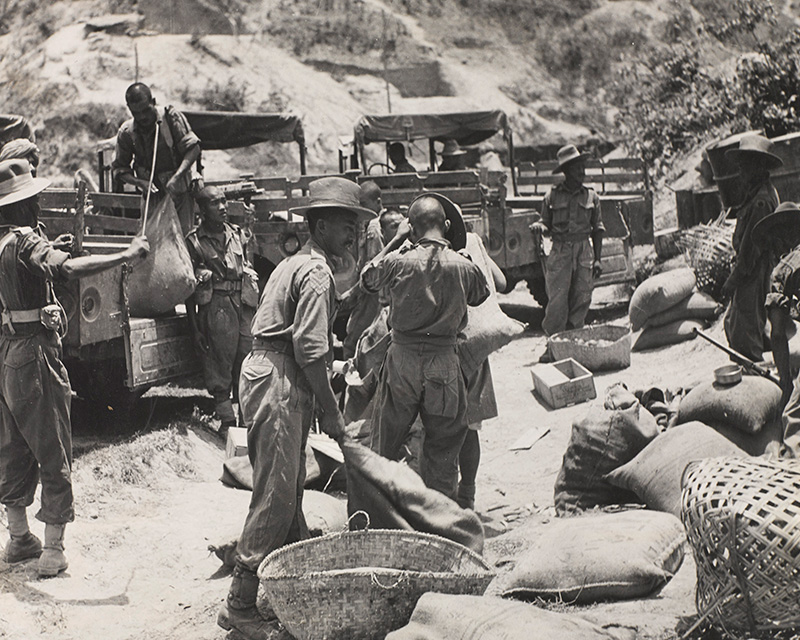
Supply drops
As the British and British Indian Armies advanced through Burma, there was a growing strain upon Allied supply lines. The challenging terrain often meant that air drops were required to keep front-line soldiers supplied.
‘The GOC [General Officer Commanding] saw me, deserted his conference, and shook me warmly by the hand embarrassing me exceedingly with his congratulations. He was good enough to conclude by saying that it was “a thoroughly well-earned DSO [Distinguished Service Order]”.’Major Christopher John Sambrooke Burne, Royal Artillery, recounts the awarding of his DSO in a letter to his parents. Burne played an important role in holding off a Japanese counterattack during the Irrawaddy River Operations.
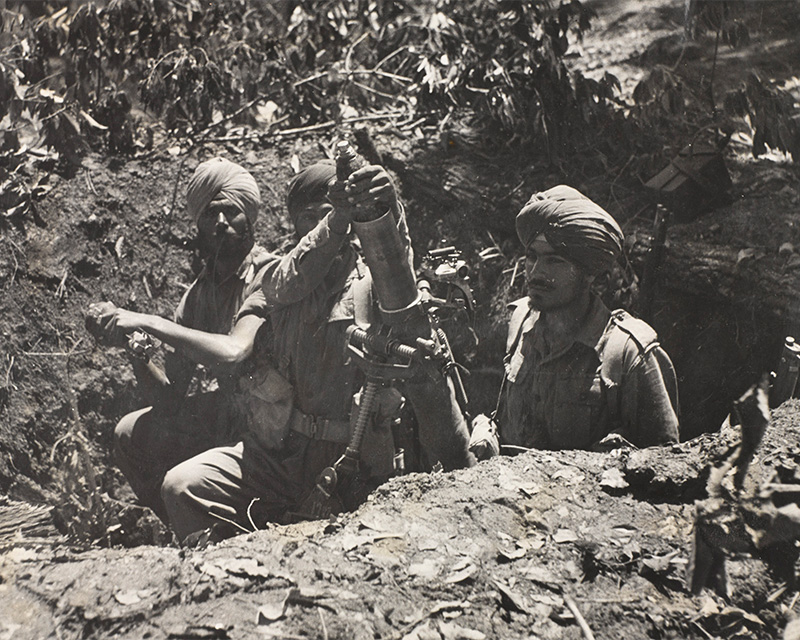
An international effort
A diverse international force led the offensive in Burma, including troops from Britain, India, West Africa, East Africa, and across the Commonwealth. Pictured above are soldiers of the 2nd Punjab Regiment operating a mortar.
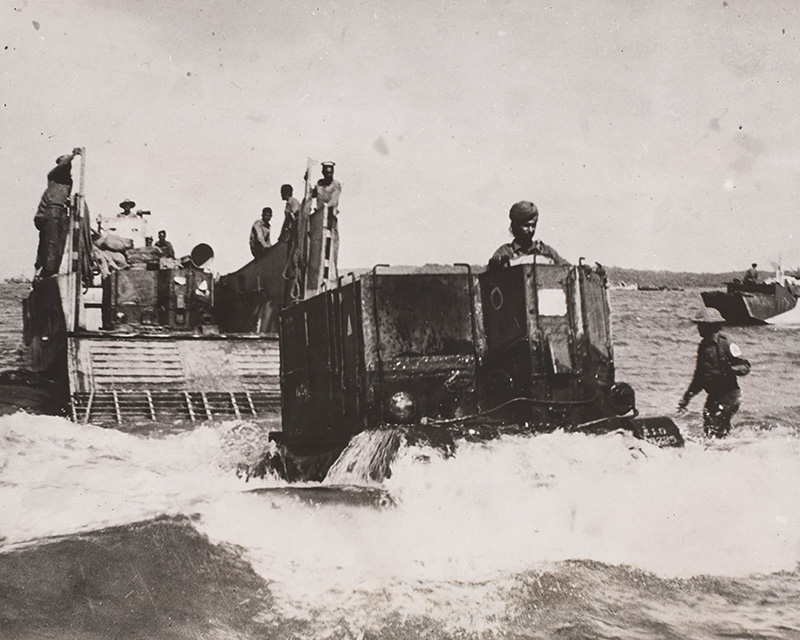
Battle of Ramree Island
7-17 February 1945
Following earlier landings on Ramree Island in Burma, soldiers of the Indian Army reached the town of Ramree itself on 7 February. Within 10 days, Japanese resistance on the island had ceased altogether.
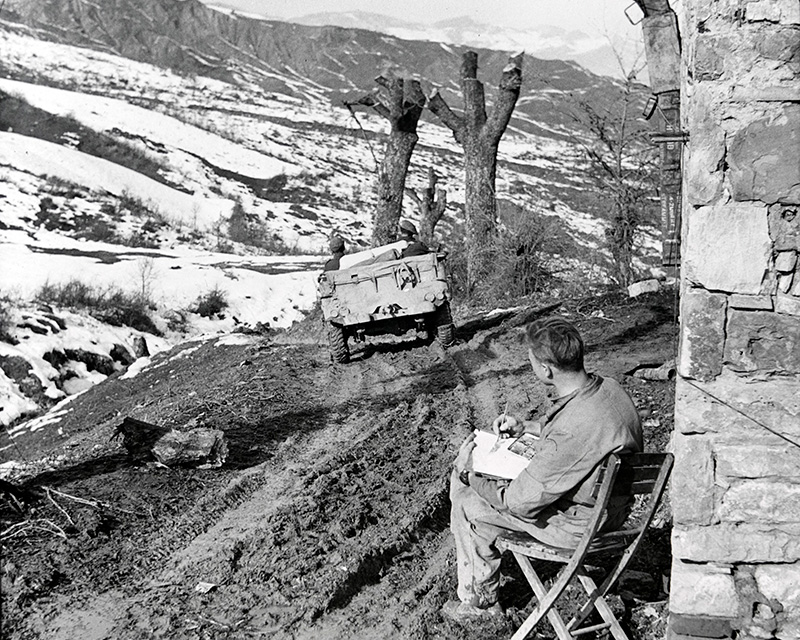
Italian offensive on hold
In Italy, the Allied offensive remained on hold until the spring. For some soldiers (like Lance Corporal Sibbald, pictured above), this offered a chance to enjoy some artistic pursuits.
Operation Veritable
8 February – 11 March 1945
Operation Veritable was launched in conjunction with a US offensive, Operation Grenade, with the aim of clearing German forces west of the Rhine. During February, British and Canadian forces advanced through the Reichswald in Germany, close to the border with the Netherlands.
‘February was spent in building up supplies in the area beyond the Maas just over the German border and in ferrying troops in and out of the line while the area between the Maas and the Rhine was clear.’War Diary, Royal Army Service Corps, recording events south-east of Nijmegen, Netherlands — February 1945
Flooding delays Allied advance
German troops destroyed dams to deliberately flood the land and delay the Allied advance through the Netherlands. It caused the US Army to postpone their attack and left British and Canadian soldiers to bear the brunt of the German Army’s resistance. The photograph above shows a Weasel cargo carrier and a DUKW truck navigating a flooded road near Nijmegen.
‘About midday our Sgt. Major visited us and told us we would have to be prepared to move fairly quickly as the Nijmegen-Krannenburg road was flooding and water was rising, the Germans had opened the flood dykes to prevent reinforcements getting through. Duks and Buffalo troop carriers, waterborne vehicles, were now being used to reinforce the troops in Kleve, so with our remaining tank crews as well as the wounded we made our way out by boat!’Trooper Ernest Leppard, Sherwood Rangers Yeomanry, recording events near Nijmegen, Netherlands — February 1945
Treaty of Varkiza signed in Greece
12 February 1945
Throughout this period, British soldiers remained in Athens in support of the Greek government. On 12 February, anti-Nazi partisans, many of them communists, made an agreement with the new Greek government to surrender their weapons in exchange for free participation in politics.
However, in the months that followed, Greek communists were denied their legal and political rights, prompting a period of simmering tensions and political violence that would eventually erupt into civil war.
Private George Hadfield is awarded the Military Medal
On 15 February 1945, Bren gunner George Hadfield was with the Gloucestershire Regiment on the Shweli River in Burma, near its confluence with the Irrawaddy, when a party of 18 Japanese soldiers led a bayonet charge on his platoon.
His official citation remarks that the ‘cool bravery of this private soldier at a critical juncture of the engagement was of the highest order, and it was mainly due to his offensive determination and readiness under fire that the Japanese were prevented from breaking through his sector’.
Troops in Tilburg await the final push
In October 1944, the residents of the Dutch town of Tilburg had met their British liberators with wild celebrations. As elsewhere in the Netherlands, jubilant civilians also singled out alleged collaborators for public humiliation and punishment.
By February 1945, British soldiers were still stationed in Tilburg as the British Liberation Army became partly responsible for the administration of liberated towns and cities across Western Europe. The photograph above shows British tanks parked up on a residential street.
‘One day I told a Belgian Workman – a Walloon – what I thought of him in my very bad French. The O.C. [Officer Commanding] was passing by and he sent for me... He asked “Do you speak this language or any other?” I replied, “I spoke a little very bad French and German.” He said “Well you’ll do. From tomorrow you will take charge of recruiting and using Civilian Employees.”’Lance Sergeant Joe Ashley, Royal Armoured Corps, recalling events in Brussels, Belgium — February 1945
Operation Cold Comfort/Zombie
17 February – March 1945
On 17 February 1945, a 12-man ski team of SAS soldiers parachuted into Italy, north of Verona, with the aim of blocking the main railway line through the Brenner Pass. Yet the men became scattered upon their arrival and, unable to reach their objective, were forced into hiding. Captain Littlejohn, commanding the mission, and Corporal Crowley were both captured and executed. The survivors sought extraction in late March.
‘I and another chap had an afternoon off, incidentally the only one I have had since mid-November. We hitch-hiked to Imphal where we went to the Officers’ Shop, walked round the bazaar and saw the town without realising that we had done so! We had tea at the Officers’ Club with a chair and a tablecloth, curtains and pictures – in a proper house. It was so good that we stayed on to supper, which was roast duck well cooked. There was a bar, and a barman, with notices all round about the price of drinks... something prompted me first to ask the barman what he had. “Some water and enough lime juice for one small one all round.” This made us chuckle for quite a long time as it was such a wonderful anti-climax.’Captain Peter Whitfield Gallup, Royal Field Artillery, serving with Air Photo Intelligence in India and Burma — 21 February 1945
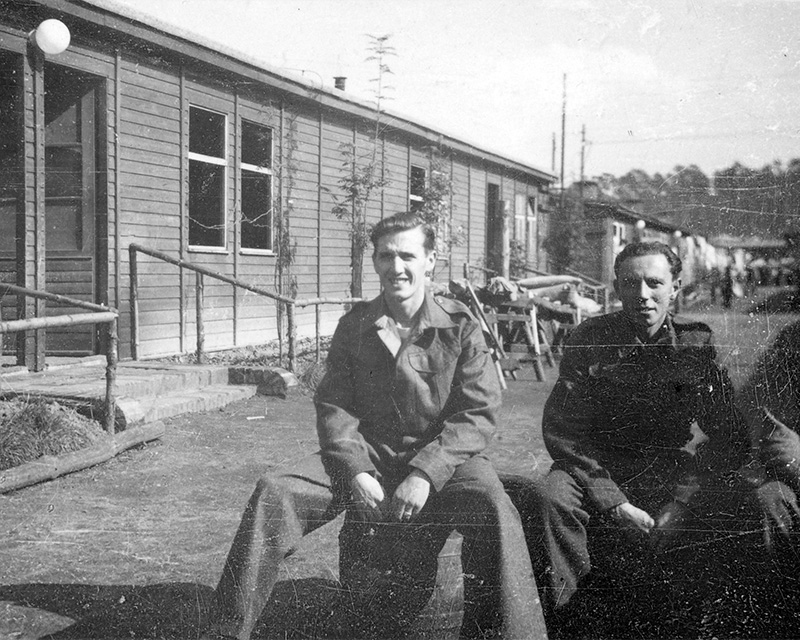
Prisoners of war in Europe
More than 170,000 British soldiers were taken prisoner in Europe during the Second World War. While officers were customarily exempted from work duties, other ranks were routinely given labour details during their stay in captivity.
In the midst of harsh winters, and with meagre rations and poor-quality accommodation, conditions were often difficult. For most prisoners, the greatest battle was against boredom. Few men had the energy to contemplate escape attempts.
The photograph above is from Stalag XXI-D in Posen (present day Poznań, Poland).
‘This week has been a record for illness. We all have rotten colds – it has run all round the Stube [room] – 40 of us. Tons of snow and very cold still. But hope you are free from colds yourself. Still plenty of work and the hours are long. Am on night shift every other week on a metal press. Have a pretty decent chap in charge named Max, who has a bit of sympathy for us. No cigarettes or mail yet, but tell Hilda to get the baking pans ready as we are betting on seeing you in the near future.’Letter home from a British prisoner at Stalag IV-D camp in Germany — 23 February 1945
Destruction of Kleve
Towards the end of February, British and Allied forces advanced ever closer to the Rhine River. The town of Kleve was largely destroyed from repeated Allied aerial bombardments in the lead-up to the ground assault. The photograph above shows a Cromwell tank advancing along one of its devastated streets.
‘26 February. At 0400 hrs, the first wave of 3rd Canadian Division passed through with the right flank on the Battalion: by 1100 hrs the Germans had been driven from Hollen and Keppeln. All the companies had a dress circle view of the attack and, in addition to the pre-arranged fire programme which had been shot by the 3-inch Mortars as a prelude to the assault, the Divisional Artillery was held ready to engage opportunity targets on the Battalion’s reports... 67 Prisoners of War came through the Battalion... They were dazed, filthy and starving and of no great use.’War Diary for 1st (Motor) Battalion, Grenadier Guards, recording events near Uedem, Germany — 26 February 1945
Operation Blockbuster
26 February – 3 March 1945
After the progress made during Operation Veritable had proven slower and more costly than expected, the 21st Army Group launched Operation Blockbuster. Now, British and Canadian divisions advanced towards the German town of Xanten. On 3 March, they finally linked up with US forces near Geldern, about 15 miles (24km) further south.
The cost of victory
British forces had encountered fierce resistance from the German Army in the Reichswald. On 26 February, the town of Uedem was conquered with the loss of several men. Shortly afterwards, a war graves cemetery (pictured above) was established nearby to lay to rest those who had been killed in the fighting.
It is estimated that between June 1944 and May 1945 more than 130,000 soldiers of the British 21st Army Group were killed, wounded, captured or went missing during the advance from Normandy to Germany.
On This Day: 1945
This is the second instalment of a new series exploring the British Army's role in 1945 - one of the most decisive years in modern history - drawing upon the National Army Museum's vast collection of objects, photographs and personal testimonies.
Throughout 2025, a new instalment will be released each month that focuses on events from 80 years beforehand. The series will highlight the everyday experiences of Britain’s soldiers alongside events of grand historical significance.

